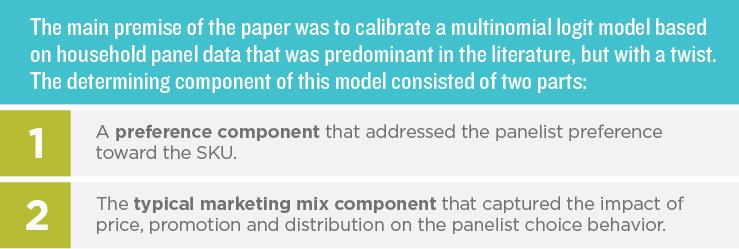
It is really amazing that almost 20 years have passed since the landmark article “Modeling Consumer Choice Among SKUs” by Peter S. Fader and Bruce G.S. Hardie in the Journal of Marketing Research (November, 1996). The following year, it was winner of the prestigious 1997 Paul E. Green Award for demonstrating the most potential to contribute to marketing research. If the judges from 1997 took a look at Middlegame, they would see that when the article is translated into the Multiplicative Competitive Interaction (MCI) framework of Cooper and Nakanishi, the entire foundation of Middlegame and its use of regular assessment of incrementality versus transferred demand is substantiated.

The first component was more than an addition to multinomial logit; it was groundbreaking. That’s because the preference component breaks down the SKU into a series of attribute-specific effects aligned with original applications conjointly developed by the same Paul E. Green in 1970. In the Fader and Hardie article, the authors presented the fabric softener category as an example using 22 attribute levels:

Through these 22 attribute levels, they were able to explain each of the existing 56 SKUs present in the data. However, the attribute levels could actually describe 10 x 4 x 4 x 4, or 640, potential unique SKUs. With a subsequent marketing plan (price, promotion and distribution), Fader and Hardie could immediately forecast and rank the sales opportunity of the other 584 SKUs that were not yet in existence. As a practitioner, I immediately paid attention to this absolutely brilliant capability.
However, the parsimonious aspect of their solution is what brought our Competitive Interaction Analysis (CIA)® platform to life. Fader and Hardie explained the 56 SKUs with just 22 attribute level variables. In traditional choice models, a single preference component would be created for each of the 56 SKUs, so we immediately cut the number of model coefficients by (56 – 22) ÷ 56 = 61%. In our last analysis, we looked at 8,155 UPCs which were reduced to 182 attribute levels. Even with today’s computing horsepower, our Bayesian modeling engine would struggle to converge in a reasonable timeframe if we needed to calibrate 45 times the number of parameters. Fader and Hardie changed everything and we are eternally grateful to these Middlegame heroes.

They regularly present an introductory and advanced tutorial at the annual ART forum which we highly recommend that you check out.
Middlegame is the only ROMI consultancy of its kind that offers a holistic view of the implications of resource allocation and investment in the marketplace. Our approach to scenario-planning differs from other marketing analytics providers by addressing the anticipated outcome for every SKU (your portfolio and your competitors’) in every channel. Similar to the pieces in chess, each stakeholder can now evaluate the trade-offs of potential choices and collectively apply them to create win-win results.
